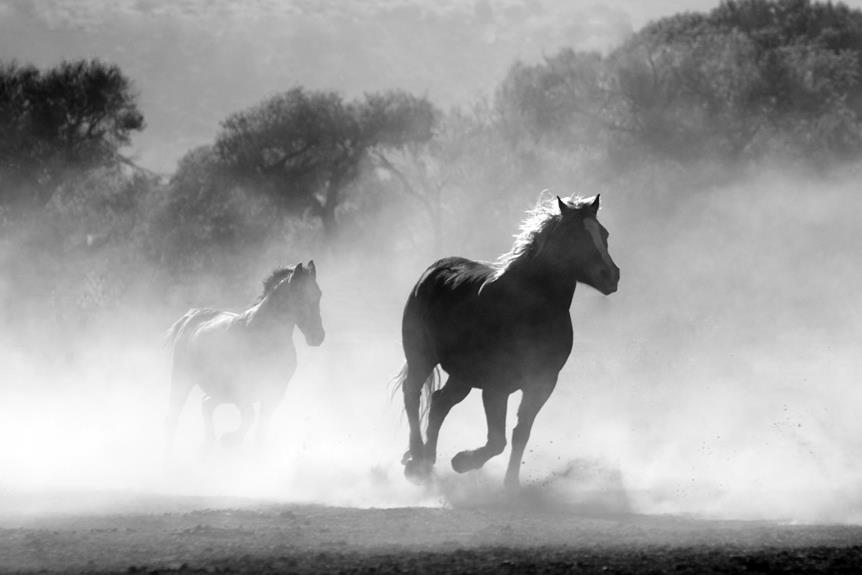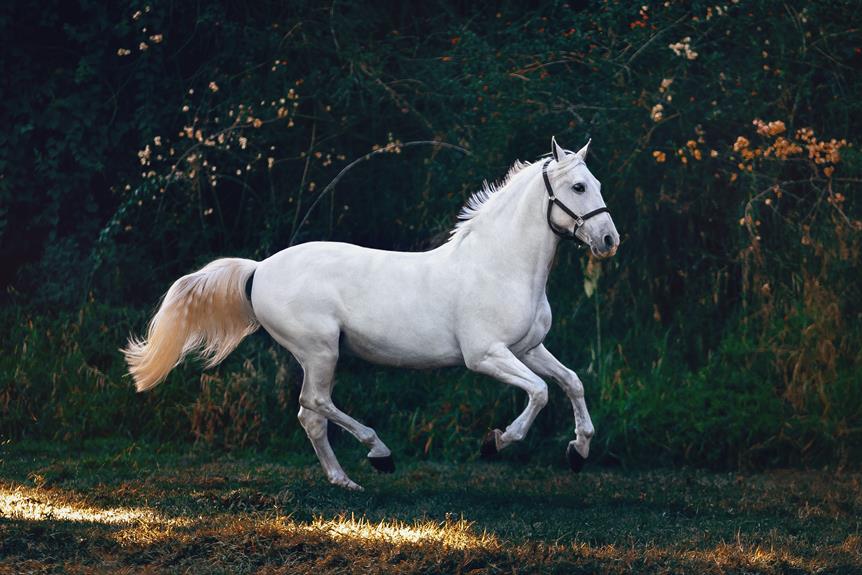So, you're curious about spurs, huh? Well, let's take a moment to ponder the deep philosophical question of what these peculiar metal objects are actually for.
Are they tiny weapons to conquer stubborn horses? Or perhaps a trendy fashion accessory for riders? The truth is, spurs serve a much more practical purpose in the equestrian world. They are tools used to enhance communication between rider and horse, allowing for subtle cues and precise control.
But that's just the beginning of the story. Stay tuned to uncover the fascinating history, the different types, and the proper use of spurs. It's a journey worth embarking on, my friend.
Key Takeaways
- Spurs have a rich historical background, dating back to ancient times.
- Spurs are a tool that riders use to provide subtle cues and aids to their horses.
- The purpose of spurs is to refine communication and encourage responsiveness to the rider's aids.
- Different types of spurs allow riders to fine-tune their aids according to their specific needs.
The History of Spurs
Spurs have a rich historical background, dating back to ancient times, and have evolved to become an essential tool for riders today. The use of spurs by horse riders can be traced back to the ancient Greeks and Romans, who used them to make their horses move in certain ways.
In the Middle Ages, spurs became an important part of the knight's attire and were used to control their horses during battle.
In the cowboy era of the American West, spurs became synonymous with the image of the rugged cowboy and were an essential part of their equipment. The design of spurs varied in the Western world, with different regions having their own unique styles.
Today, spurs are still used by riders in various disciplines, such as dressage and Western riding. They're used to provide subtle aids to the horse, helping the rider communicate their desires more effectively.
Spurs aren't meant to be used as a form of punishment, but rather as a way to elicit responses from the horse to the rider's cues. It's important for riders to use spurs correctly and with skill, as incorrect use can cause discomfort or harm to the horse.
Evolution of Spurs
Throughout history, the design and functionality of spurs have undergone significant changes, allowing for more effective communication between riders and their horses. The evolution of spurs has led to the development of various types of cowboy spurs, each catering to different riding styles and preferences.
Here are five key points to help paint a picture of the evolution of spurs:
- Cowboys wear spurs to enhance their control over their horses. Spurs are used as an aid to communicate with the horse, providing subtle cues and directing their movements.
- Western spurs, specifically designed for cowboys, often have a rowel, a wheel-shaped attachment with radiating points, which gently nudges the horse's flank to encourage specific actions.
- Cowboys must use spurs correctly to avoid causing discomfort or injury to the horse. Proper training and skill are necessary to ensure that the spurs are used in a humane and effective manner.
- The design of cowboy spurs has evolved over time, with variations in shank angles, the addition of chap guards to protect the rider's legs, and the inclusion of jingo bobs for decoration and sound.
- Different kinds of cowboys may prefer specific types of spurs based on their riding style and the demands of their work. From ranch cowboys to rodeo riders, various spurs are available to suit their individual needs.
Purpose of Spurs
To better understand the significance of spurs, it's important to recognize their role in enhancing the communication between riders and their horses. Spurs are a tool that riders use to provide subtle cues and aids to their horses. By attaching spurs to their boots, riders can use their leg to give specific instructions to the horse. The pressure applied by the spur can be used to guide the horse's movement with greater precision. Different types of spurs, such as western spurs and eastern spurs, allow riders to fine-tune their aids according to their specific needs.
It's crucial to use spurs correctly to avoid causing harm to the horse. The purpose of spurs isn't to hurt the horse, but rather to refine communication and encourage responsiveness to the rider's aids. Horse trainers often emphasize the importance of using spurs in a gentle and controlled manner. It's also essential to ensure that the spur is properly attached to the boot using a spur strap or heel band.
Different Types of Spurs
There are various types of spurs, each with their own distinct benefits and functions. Here are five different kinds of spurs that riders use:
- Ballpoint Spurs: These spurs have a smooth, rounded ball at the end, which makes them less likely to cause discomfort or injury to the horse. They're commonly used by riders who need to give subtle cues to their horses.
- Prince of Wales Spurs: These spurs have a small, straight neck and a blunt end. They provide more precise and direct contact with the horse's sides, making them suitable for more experienced riders who require greater control and responsiveness.
- Western Spurs: These spurs have a rowel, which is a revolving wheel with small points. They're commonly used in Western riding disciplines and are designed to provide clear instructions to the horse without causing harm.
- Eastern Spurs: Eastern spurs, also known as English spurs, have a longer and thinner neck compared to Western spurs. They're typically used in English riding disciplines, such as dressage and show jumping, to provide refined and subtle aids.
- Fake Spurs: Some riders may choose to use fake spurs, which are non-functional decorative accessories. These spurs aren't designed to elicit a response from the horse and should never be used to replace the correct use of spurs.
Proper Use of Spurs
When using spurs, it's important to understand the proper techniques and guidelines to ensure the well-being and effective communication with your horse. Using spurs correctly can help you communicate your intentions to your horse more effectively. However, it's crucial to remember that spurs should never be used to hurt or force your horse to move faster. Instead, they should be seen as a tool to refine your aids and give subtle cues.
First and foremost, it's important to wear spurs only when necessary. Not every rider will need spurs, and they should only be used by riders who are trained to use them properly. When wearing spurs, ensure that they're in the correct position on your boots. This means that the shank should be positioned correctly on the heel of your boot, and the rowel should be able to spin freely.
Frequently Asked Questions
What Do You Need Spurs For?
You need spurs in horseback riding to effectively communicate with your horse and provide subtle aids. Different types of spurs serve specific purposes, but proper technique and control are crucial to avoid harm.
Do You Really Need Spurs?
Do you really need spurs? The pros of using spurs include enhanced communication and refined riding aids. However, alternatives like training, correct leg positioning, and using other aids can be effective too. Proper technique and understanding horse behavior are crucial for their welfare.
Is It OK to Wear Spurs in Public?
Yes, it's okay to wear spurs in public. Spurs can be a fashion statement, have cultural significance, and reflect historical context. The practicality debate, social acceptance, and fashion trends make them a personal expression and cowboy boot accessory. Symbolism analysis and impact on foot health should also be considered.
Did Cowboys Really Wear Spurs?
Cowboys indeed wore spurs as part of their iconic fashion. Spurs have a rich history in Western culture and were made in various types. They symbolize the cowboy way of life and were worn by famous cowboys. The sound of spurs is significant in Western movies. Spurs continue to be used in modern horseback riding, but alternatives exist for controlling horses. They play a role in competitive riding disciplines.
Conclusion
In conclusion, spurs are a valuable tool for riders to communicate with their horses and apply specific pressure. They help riders direct horses more effectively and make horses respond to subtle aids.
However, it's important to remember that spurs should only be used when absolutely necessary, and alternative methods of communication should be explored first.
By understanding the history, evolution, purpose, and different types of spurs, riders can use them properly and enhance their riding experience.



0 Comments